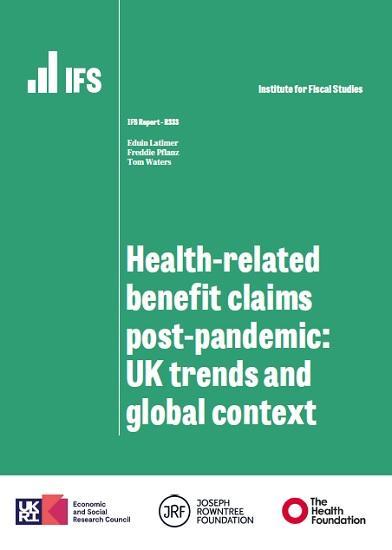Health-related Benefit Claims Post-pandemic - UK Trends And Global Context
23rd September 2024

How do post-COVID claimants of health-related benefits compare with pre-COVID claimants? Where in the UK are they? How do other countries compare?.
Individuals in the UK with health conditions may be entitled to two types of benefits - incapacity benefits (for those whose condition prevents them from working) and disability benefits (to help with extra living costs arising from the disability).
Since the onset of the pandemic, there has been a substantial increase in the number of individuals claiming these ‘health-related' benefits - and official projections suggest that claimant numbers will rise further still.
This report explores how the new claimants compare with those who began claims before the COVID-19 pandemic, the geography of new claims, and how the UK's experience compares with that of other developed countries.
Key findings
1. Over the last four years, there has been a large increase in spending on working-age health-related benefits, from £36 billion in 2019-20 to £48 billion in 2023-24, and official forecasts expect this spending to increase further to £63 billion in 2028-29 (all in 2024–25 prices.) Total health-related benefits spending for all ages has increased from £52 billion in 2019–20 to £65 billion in 2023–24. The increase in working-age spending has been mostly driven by an increasing caseload: from 2.2 million in 2019–20 to 3.2 million in 2023–24 for disability benefits (39% growth) and from 2.5 million in 2019–20 to 3.2 million in 2023–24 for incapacity benefits (28% growth).
2. The rapid growth in health-related benefits seems to be largely a UK phenomenon. The number of claimants of similar benefits in most similar countries with available data (Australia, Austria, Canada, Germany, Ireland, the Netherlands, Sweden and the US) has in fact slightly fallen over the same period. There have been small percentage increases in claims in France and Norway. Denmark was the only other country with available data that saw a significant increase and, at 13%, even that was considerably smaller than the increase in health-related benefit claimants in the UK (where claimants for disability benefits have increased by more than 30%).
3. Following recent increases, UK health-related benefits spending is similar to that in comparable countries. Across the OECD (a club of rich countries), spending on working-age health-related benefits averaged 1.6% of GDP in 2019 (latest data). At that point, UK spending was considerably below that level, at 1.3% of GDP; the recent rises have pushed that figure to 1.7%. If spending on health-related benefits continues to grow (as forecast) to 2.1% of GDP in 2028, the UK will likely become one of the highest spenders on health-related benefits amongst comparable countries.
4. The increase in UK disability benefit claimants is due to both more people beginning claims and fewer people ending claims. Before the pandemic, around 250,000 people in England and Wales would start getting working-age disability benefits each year. These figures started to rise in mid 2021, and in the latest data (year to November 2023) almost 500,000 people began claiming disability benefits. At the same time, the share of claimants ending their claim has fallen, from 9.0% in 2019 to 7.4% in 2023. Overall, we estimate that at least two-thirds of the rise in the caseload is explained by an increase in the number of people beginning claims.
5. The new claimants of disability benefits are in some ways not like those who were beginning claims shortly before the pandemic. First, they are younger. The number of new awards made to under-40s has grown by 150% (from 4,500 a month in 2019–20 to 11,500 in 2023–24); growth for 40- to 64-year-olds was ‘only' 82% (11,000 a month to 20,000 a month). Second, current new claimants are more likely to claim due to mental health problems (including learning disabilities). In 2019–20, 28% of all new awards were primarily for mental health conditions (3,900 claims a month); that figure now stands at 37% (12,100 a month), a 9 percentage point increase. Only 2 percentage points of this rise is accounted for by the increasing rate of claims among younger individuals – there has been a marked rise in claiming for mental health reasons at all ages. Third, new claimants are slightly more likely to be women, whose share of new claims has grown from 55% in 2019–20 to 58% in 2023–24.
6. New claimants have a similar attachment to the labour market now as they did before the pandemic. Both prior to and since the pandemic, the share of new disability benefit claimants out of work was around 70%. There has been a slight increase in the share of new claimants who have worked within the last two years, from 37% to 40%, but it remains the case that most new disability benefit claimants have been out of work for more than two years.
7. Broadly, the growth in claims has been fastest in areas that already had a large number of claimants. For example, in Merthyr Tydfil and Blackpool, around 15% of 16- to 64-year-olds were in receipt of a health-related benefit before the pandemic. Now that figure is around 19%. Conversely, in Windsor & Maidenhead and Wokingham, around 3% were receiving one of these benefits before the pandemic, and now around 4% are. After accounting for the pre-pandemic number of claimants, there is no relationship between the growth in claims and the local employment rate, or how the local employment rate has changed since the pandemic.
Read the full IFS report HERE
